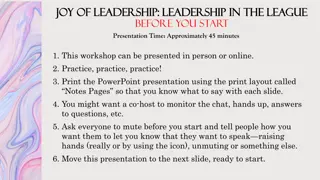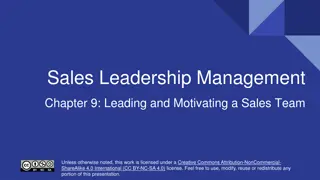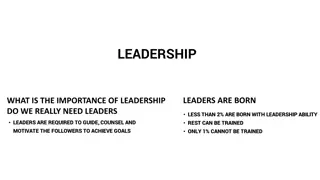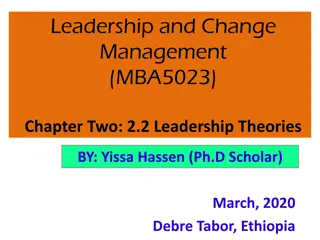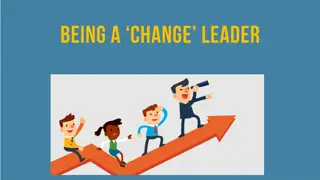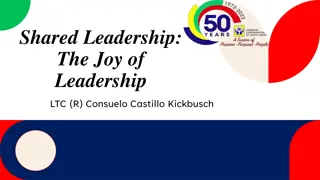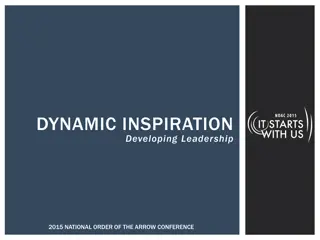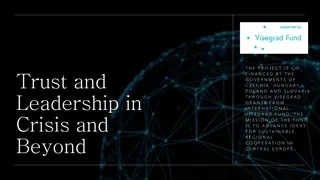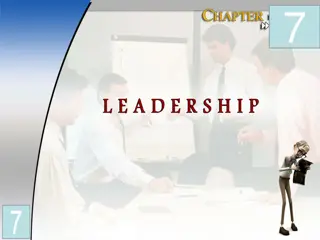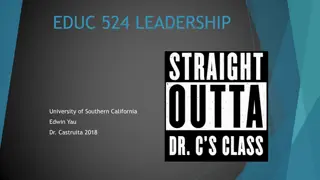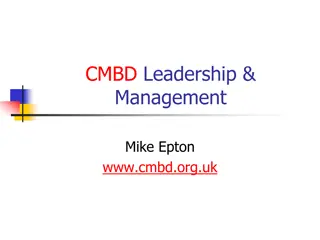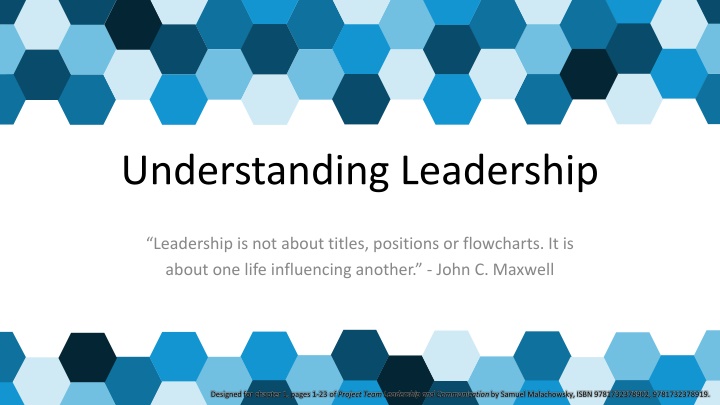
Understanding Different Leadership Styles for Effective Team Management
Explore the nuances of leadership through various styles such as Affiliative, Authoritarian, and Coaching. Learn how to adapt leadership approaches to suit team dynamics and goals for optimal performance and cohesion.
Download Presentation

Please find below an Image/Link to download the presentation.
The content on the website is provided AS IS for your information and personal use only. It may not be sold, licensed, or shared on other websites without obtaining consent from the author. If you encounter any issues during the download, it is possible that the publisher has removed the file from their server.
You are allowed to download the files provided on this website for personal or commercial use, subject to the condition that they are used lawfully. All files are the property of their respective owners.
The content on the website is provided AS IS for your information and personal use only. It may not be sold, licensed, or shared on other websites without obtaining consent from the author.
E N D
Presentation Transcript
Understanding Leadership Leadership is not about titles, positions or flowcharts. It is about one life influencing another. - John C. Maxwell Designed for chapter 1, pages 1-23 of Project Team Leadership and Communication by Samuel Malachowsky, ISBN 9781732378902, 9781732378919.
Job Titles Loosely correlated to actual duties of jobs The actual title can affect perceptions Manager vs. Coach vs. Foreman Project Manager title can mean any number of things
Leadership Styles Leadership style should be chosen based on the team s features, what they are trying to achieve, and the individuals Leaders have a default style they prefer This may not be appropriate for their team Stress or circumstances can cause leaders to choose or revert to the wrong style There are dozens (7 main styles covered here) Goleman, Daniel. Primal Leadership: Realizing the Power of Emotional Intelligence. Boston, Mass. :Harvard Business School Press, 2002.
Affiliative Leadership Style Emphasizes connection, harmony, and conflict resolution Good for hurting teams in need of a morale boost Can be abused Works best in combination with others Diagram: Malachowsky, Samuel. Project Team Leadership and Communication. Lintwood Press. 2018. p. 3. Goleman, Daniel. Primal Leadership: Realizing the Power of Emotional Intelligence. Boston, Mass. :Harvard Business School Press, 2002.
Authoritarian / Commanding / Autocratic Leadership Style Classic leadership structure Strong, dominating leader(s) Can cause poor morale if teams aren t used to it Good for emergencies/crisis situations Diagram: Malachowsky, Samuel. Project Team Leadership and Communication. Lintwood Press. 2018. p. 3. Goleman, Daniel. Primal Leadership: Realizing the Power of Emotional Intelligence. Boston, Mass. :Harvard Business School Press, 2002.
Coaching Leadership Style About connecting the goals of the team/project with individuals Best for teams who have the desire to succeed and are motivated Can lead to micromanagement Diagram: Malachowsky, Samuel. Project Team Leadership and Communication. Lintwood Press. 2018. p. 3. Goleman, Daniel. Primal Leadership: Realizing the Power of Emotional Intelligence. Boston, Mass. :Harvard Business School Press, 2002.
Democratic Leadership Style Relies on the skills and knowledge of team members Group makes decisions collectively Can be time consuming and difficult for indecisive teams Diagram: Malachowsky, Samuel. Project Team Leadership and Communication. Lintwood Press. 2018. p. 3. Goleman, Daniel. Primal Leadership: Realizing the Power of Emotional Intelligence. Boston, Mass. :Harvard Business School Press, 2002.
Laissez-faire Leadership Style The hands-off approach Management trusts the team members to make decisions and meaningful progress Leaders support rather than control Requires self-motivated, hard-working, honest team members Diagram: Malachowsky, Samuel. Project Team Leadership and Communication. Lintwood Press. 2018. p. 4. Goleman, Daniel. Primal Leadership: Realizing the Power of Emotional Intelligence. Boston, Mass. :Harvard Business School Press, 2002.
Pacesetting Leadership Style This is lead by example Leader is highly focused on performance and expects the same of the team Works best with teams that already perform at a high level Team members can feel as they ll never measure up, lowering moralle Diagram: Malachowsky, Samuel. Project Team Leadership and Communication. Lintwood Press. 2018. p. 4. Goleman, Daniel. Primal Leadership: Realizing the Power of Emotional Intelligence. Boston, Mass. :Harvard Business School Press, 2002.
Transformational / Visionary Leadership Style The leader focuses on setting a positive vision for the future Team members are infused with a sense of purpose and excitement Good for teams that have recently experienced failure Can become unrealistic and overly optimistic Diagram: Malachowsky, Samuel. Project Team Leadership and Communication. Lintwood Press. 2018. p. 4. Goleman, Daniel. Primal Leadership: Realizing the Power of Emotional Intelligence. Boston, Mass. :Harvard Business School Press, 2002.
Influence Not just the leader; All team members have influence on their peers Can be positive or negative Choose appropriate combinations for each peer or team member Being the boss isn t enough
Influence Types Formal / Legitimate Classic title-based position of authority Penalty / Coercive The ability or fear of punishment such as demotion Reward The ability to reward Expert A superior level of skill, experience, or knowledge Referent Based on trust and respect, similar to the influence of trusted family members
Motivators What makes us want to come to work Norms often established by industry, organization, or previous leaders What motivates you may or may not motivate others Bias towards or against individual motivators can be a factor Motivators are highly personal; the leader must consider each team member individually Divided into Extrinsic and Intrinsic motivators
Extrinsic Motivators Money / Power Want to move up in the organization or earn higher wages Classic examples: Salespeople, CEO s, Politicians Recognition Often motivated most by acknowledgement of those in power Classic examples: Entertainment, Lawyers, Interns Interpersonal Relationships Relationships with co-workers and a cooperative atmosphere are valued Classic examples: Religious Leaders, Social Workers Ryan, Richard; Edward L. Deci. Intrinsic and Extrinsic Motivations: Classic Definitions and New Directions. Contemporary Educational Psychology. 25 (1): 54 67. 2000.
Intrinsic Motivators Autonomy / Interesting Work Prefer the excitement of new and innovative endeavors Classic Examples: Architects, Engineers Purpose Need to feel that their work is beneficial to the causes they care about Classic Examples: Doctors, Teachers, Military Mastery / Exploration Personal achievement, problem solving opportunities, and creative endeavors are sought Classic Examples: Artists, Scientists Ryan, Richard; Edward L. Deci. Intrinsic and Extrinsic Motivations: Classic Definitions and New Directions. Contemporary Educational Psychology. 25 (1): 54 67. 2000.
Organizational Culture The set of behaviors or beliefs that determine how an organization or team interacts or carries out work Awareness of culture and different circumstances/attitudes is key Influenced by: The industry, environment, customers, organizational practices Personalities, values, principles, etc. of the organization, leader, and team Influences: Decision making, risk tolerance, decisiveness, orderliness, competitiveness Level of attention to detail, amount of process, emphasis on achievement Supportiveness, reward/punishment, team vs. individual contribution O Reilly, C. A. III, Chatman, J. A., and Caldwell, D. F. People and organizational culture: A profile comparison approach to assessing person-organization fit. Academy of Management Journal, September 1991. p. 502, 516. 1991.
Stakeholders Stakeholders are people who can affect or are affected by the execution or outcome of a project Diagram: Malachowsky, Samuel. Project Team Leadership and Communication. Lintwood Press. 2018. p. 12.
Project Management The Discipline Can have many titles: Project Leader, Coordinator, Planner, Manager, Team Leader, Program Manager, Technical Lead, etc. May not have direct (hire/fire) authority Manages project outcomes, schedules, resources, and documentation Large amounts of time often committed to project management tools, meetings, and communication Professional certifications available (PMP, CAPM)
Project Management Professional Ethics Ethics (self-discipline) are key to professionalism Ethics influence and are influenced by organizational culture Examples Honesty regarding qualifications Protecting proprietary information Confronting conflict directly Disclosing conflicts of interest Focusing on mutual cooperation Advocating for team members and stakeholders Includes elements from the Project Management Institute s 2006 Code of Ethics and Professional Conduct
Summary and Conclusions A leader s title isn t everything We must be intentional in how we influence and motivate others Awareness of various types and techniques is key Culture influences every aspect of the organization and team Stakeholders are key to any project effort, and comprise multiple groups Project Management is an important discipline which requires diverse skills and a commitment to ethics

